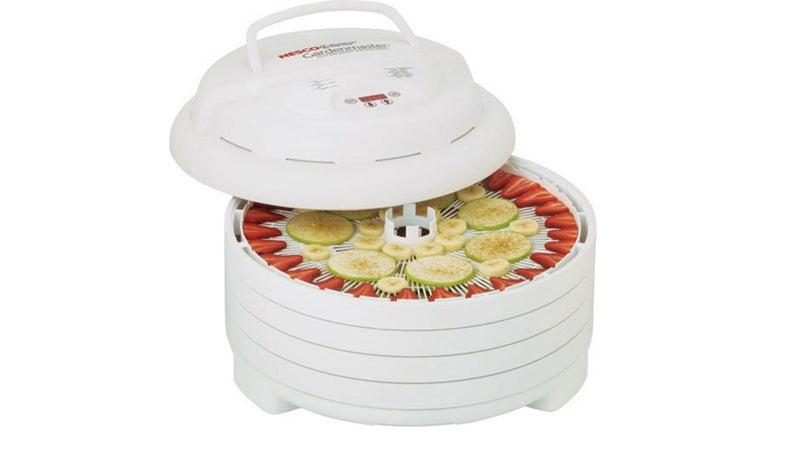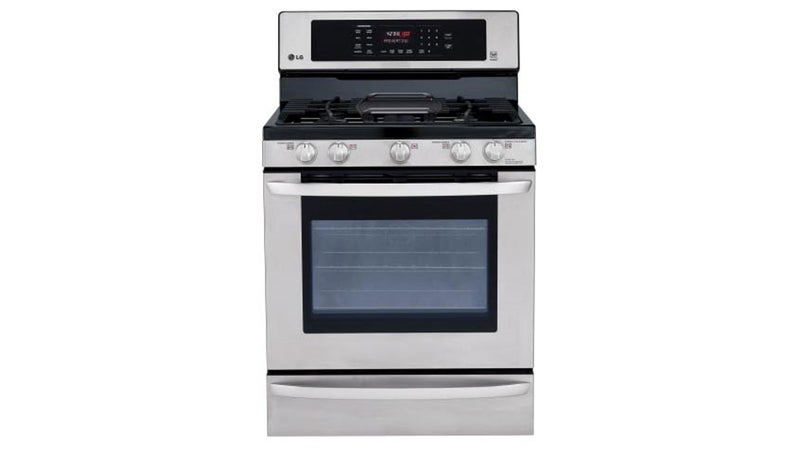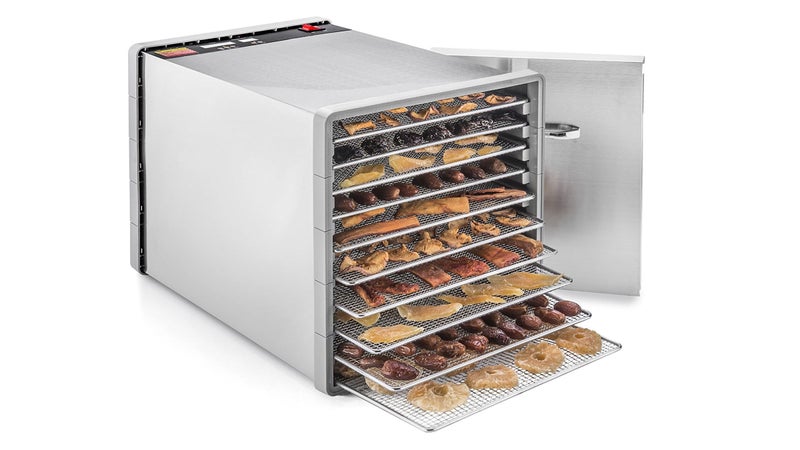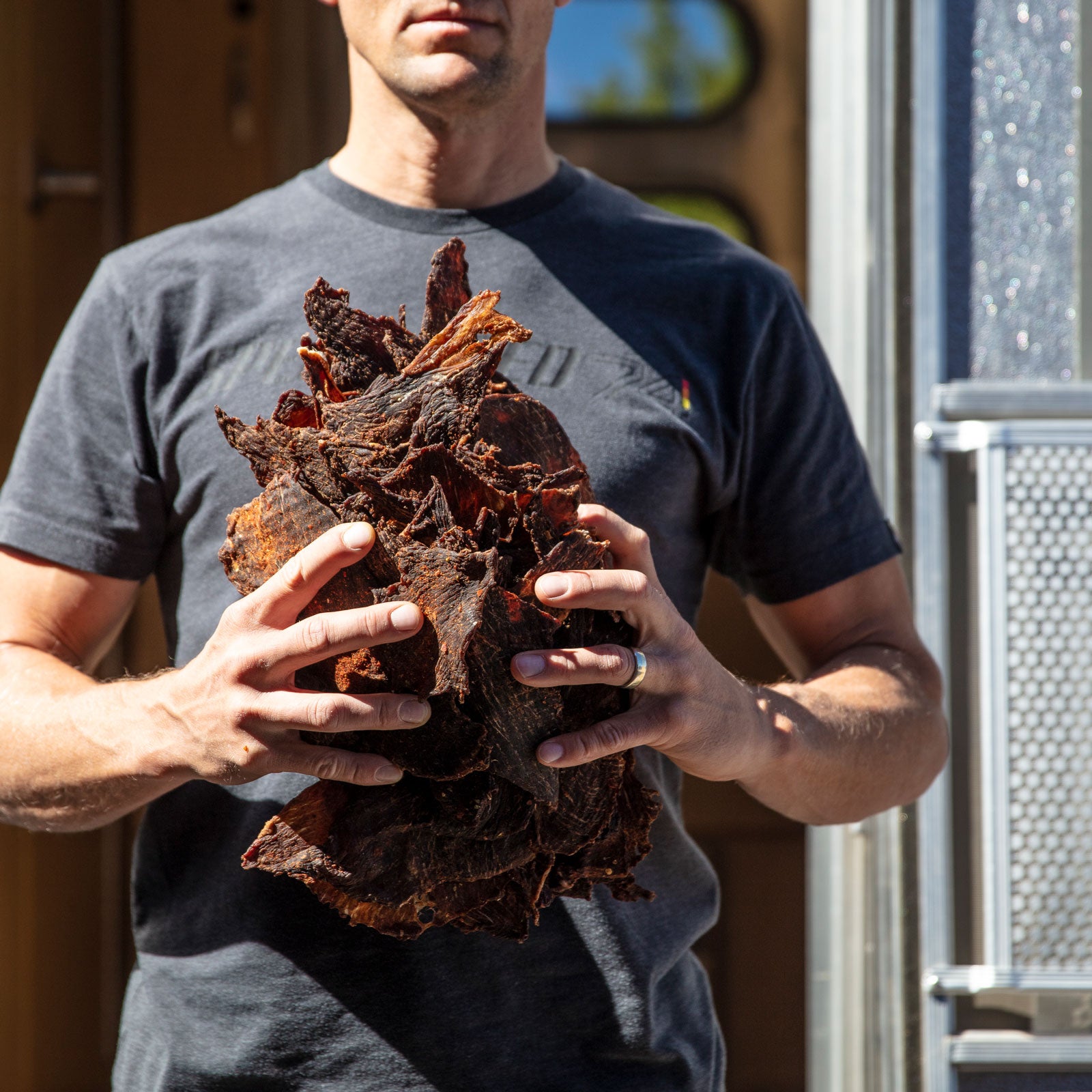If there’s one thing Jen and I miss about our fixed-address life in Santa Fe, New Mexico, it’s elk meat. We took up game hunting six years ago and haven’t purchased red meat in a store since. But the freezer in Artemis the Airstream is the size of a shoebox, which means the only time we get steaks or burgers is when we pass through Santa Fe and bother our renters to let us raid the stand-up freezer in the garage.
Some friends suggested we dry batches of meat so we can take more along with us. They have a huge garden and orchard and use a dehydrator to preserve much of their summer bounty.
I’m no stranger to drying. To save costs in college, I bought closeout, barely salvageable fruit from the grocery and spent late nights reducing batch after batch in a beat-up dehydrator I picked up for $12 from a thrift store. The results were passable, but what I remember most is the variability—apricots ranging from rubber-cement medallions to tooth-splitting sour suckers—as well as the laborious process. If you counted the hours and hours of chopping, dicing, traying, and bagging, I probably could have afforded Harry & David.
But I do love good jerky. It’s a staple on the road, one of the few healthy snack foods you can buy almost anywhere. We eat it sparingly because of the expense. But with a freezer full of meat not getting eaten, I decided there was nothing to lose. So, the last time we passed through Santa Fe, I tracked down some dehydrators and set to work. The goal was to figure out whether we could make jerky from our elk as good as the stuff you buy in the store, and if so, how much a reasonable unit to do the job would cost.
Nesco FD-1040 Gardenmaster ($170)

To start out, I borrowed this dehydrator from a friend. It’s appealing because it’s lightweight (eight pounds), fairly compact (the size of a hatbox), and inexpensive (you can get it on for $90). The heating unit and fan are at the top. An adjustable digital gauge ranges from 90 to 160 degrees Fahrenheit. Four 15-inch diameter trays come included.
While I liked the diminutive size of the Gardenmaster in concept, it felt too small once I started loading meat. Our butcher batches our jerky-cut elk in seven-pound bags, and it took three very full cycles of the Gardenmaster to get through just one of those bags. I set the timer to the recommended four hours at 145 degrees, after which I rotated the trays for an additional two hours to get the consistency I wanted. Nesco says drying should be consistent throughout each tray, but I found that the meat dried quicker on the top two racks than the bottom.
In the end, the results were fine, but the labor of it—especially after three batches—reminded me of my college fruit all-nighters. You can expand the Gardenmaster to 20 trays, but at $25 per pair of spare racks (an additional $200 for max capacity), you might as well get a bigger unit.
Bottom Line: Great for those who dehydrate occasionally or have limited kitchen space. But if you have several hundred pounds of elk in the freezer, you’ll probably want something more robust.
LG LRG3085ST Gas Range ($1,200)

I didn’t know it, but our home oven has a dehydrate mode. After the mixed results with the Nesco, I decided to give this a try. Since the stove is already in the kitchen, it has the obvious advantages of no added expense or storage requirements. Plus, the dehydrating real estate on our oven’s three stock racks far exceeds the Nesco: I squeezed in almost five pounds of meat in a single batch. First time around, we slung the meat over the wire racks, which made for the fastest drying but also created a huge mess, thanks to the dripping marinade. This was less of an issue on the dedicated models since those can be taken apart and cleaned in the dishwasher. On subsequent batches, we lined the racks with foil to prevent spillage, which kept things neat but slowed down drying by impeding the airflow of the convection oven.
Because the dehydrate mode maxed out at 140 degrees Fahrenheit, drying times were slow—between six and eight hours. Our first batch was undercooked, and the second, which we ran two hours longer, was chewy. We split the difference on round three, and it worked out pretty well, though consistency varied from top racks to bottom and side to side, likely because of the foil.
Bottom Line: The oven made jerky that was as good the Nesco’s results, but it took a bit longer. If your oven has this feature, and you’re not super picky about consistency, it’s difficult to argue with using an appliance you already own.
STX Dehydra 600W Stainless-Steel Food Dehydrator ($260)

Curious if a pricier, larger unit would make a difference, I ordered the , which is about the size of a college dorm fridge. It has ten close-knit wire racks, onto which, with a bit of finagling, I was able to squeeze a full seven pounds of elk meat. You can set the temperature from 85 to 155 degrees Fahrenheit—though oddly, the dial displays degrees only in Celsius, so you have to do conversions—and the timer goes up to 40 hours, though I’m not sure what might take that long. The Dehydra also has proofing modes for bread and yogurt for the home gourmands.
I set my first batch for the recommended four hours at 145 degrees Fahrenheit, and 90 percent of the meat was finished when I returned—no need to swap racks throughout the process. At the end, I did move the remaining undercooked pieces onto the top rack for an additional hour, which finished it all off nicely. The consistency of the meat was more palatable and less chewy than with the other two machines. In subsequent batches, I upped the temperature to around 148 degrees Fahrenheit; all the meat was between pliable and nicely crunchy after 4.5 hours. The combination of the rear heating unit and fan plus the wire racks seems to yield consistent finishes.
The only odd thing about the Dehydra is the front door, which hangs in place but doesn’t latch down. I’ve read reports of it rattling, though ours is quiet. Still, STX makes a more powerful, unit with a latch front that costs just $40 more, which I’d be inclined to spring for.
Bottom Line: Huge capacity and consistent finishing makes this the choice if you’re going to be dehydrating frequently. But it takes up a lot of cupboard space.
The Takeaway
I’m not going to say we put a major dent in our meat supply during our last visit home. However, we did leave Santa Fe with 12 pounds of jerky. Considering you’ll often spend $20 per pound or more for jerky in the store, we’ve almost paid off the cost of a dehydrator in one long weekend of drying. While I discovered that any of these three dehydrators would get the job done, for people like us who have a lot of meat to dehydrate, a high-capacity unit like the Dehydra is optimal. In the field, we’re happy to be snacking on the meat we’ve harvested. And with several pounds of elk still in the freezer, we won’t be plunking down for energy bars again anytime soon. I am, however, on the lookout for sales on overripe fruit.


